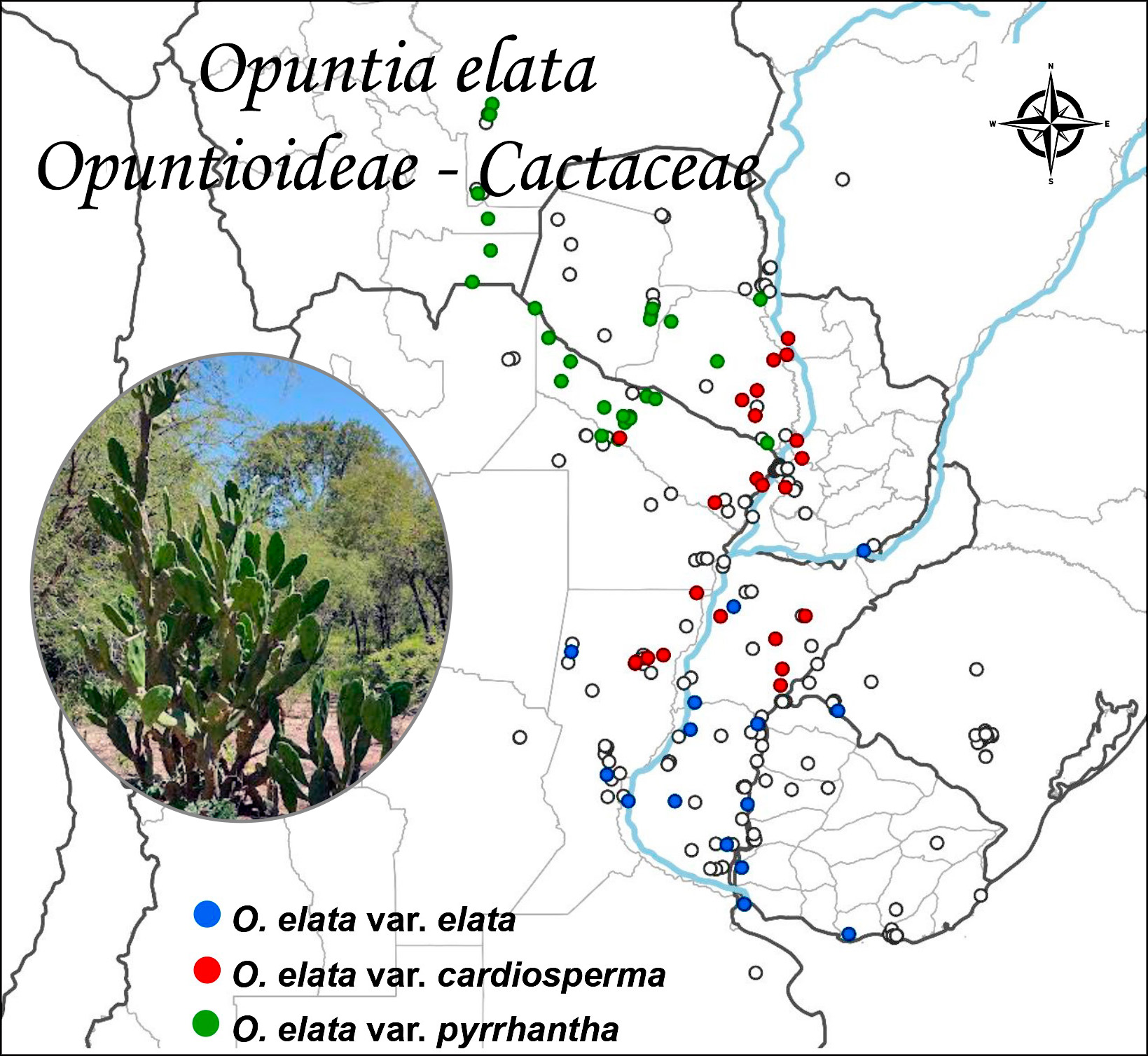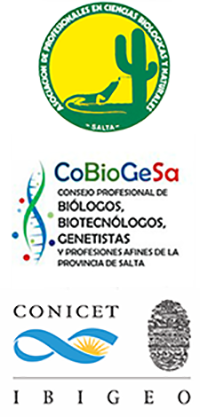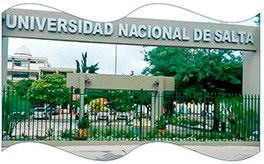Clasificación Infraespecífica y Distribución Geográfica de Opuntia elata (Opuntioideae-Cactaceae)
Palabras clave:
Complejo Elata, Cono Sur Sudamericano, Taxonomía de OpuntioideaeResumen
En el marco de los estudios de la Familia Cactaceae para el Cono Sur Sudamericano, uno de los grupos más controvertidos en cuanto a la interpretación de sus entidades y que más problemas de identificación ha generado es Opuntia ser. Armatae K. Schum. El objetivo del trabajo es aportar nueva información sobre una de las especies de dicho grupo: Opuntia elata Link & Otto ex Salm-Dyck. Como resultado se discute la afinidad de este taxón con otras especies de la Serie Armatae, y se describe una nueva variedad: O. elata var. pyrrhantha. Además, se provee una detallada descripción morfológica de la especie y sus variedades e imágenes de los principales caracteres taxonómicos, y un mapa de su distribución geográfica.
Descargas
Citas
Anderson, E. (2001). The Cactus Family. Timber Press. Portland, Oregon, USA.
APG IV. (2016). An update of the Angiosperm Phylogeny Group classification for the orders and families of flowering plants: APG IV. Botanical Journal of the Linnean Society, 181, 1-20.
Arechavaleta, J. (1905). Cactáceas. Anales del Museo de Historia Natural de Montevideo, 5(2), 161-291.
Aymerich, P. & Font, F. (2023). On the identity of Opuntia elata s.l. (Cactaceae) introduced in the Mediterranean region. A taxonomic and nomenclatural update. Mediterranean Botany, 44, 1-9.
Backeberg, C. (1958). Die Cactaceae. Handbuch der Kakteenkunde. Vol. 1. G. Fischer Verlag. Jena, Alemania.
Barthlott, W. & Hunt D. (1993). Cactaceae. En K. Kubitzki et al. (Eds.). The Families and Genera of Vascular Plants II. Flowering Plants, Dicotyledons (Vol. 1, pp. 161-197). Springer Verlag. Berlín Heidelberg. Alemania.
Barthlott, W., Burstedde, K., Geffert, J., Ibisch, P., Korotkova, N., Miebach, A., Rafiqpoor, M., Stein, A. & Mutke, J. (2015). Biogeography and Biodiversity of Cacti. Schumannia, 7, 1-205.
Berger, A. (1929). Kakteen. Anleitung zur Kultur und Kenntnis der wichtigsten eingeführten Arten. E. Ulmer Verlag. Sttutgart, Alemania.
Britton, N. & Rose, N. (1919). The Cactaceae: Descriptions and illustrations of plants of the cactus family. Vol. 1. The Carnegie Institution of Washington. Washington, USA.
Buxbaum, F. (1953). Morphology of cacti. Section II: Flower. Abbey Garden Press. Pasadena. USA.
Cabrera, A. & Willink, A. (1980). Biogeografía de América Latina. Secretaría General de la Organización de los Estados Americanos. Washington, USA.
Calvente, A., Zappi, D., Forest, F. & Lohmann, L. (2011). Molecular phylogeny of tribe Rhipsalideae (Cactaceae) and taxonomic implications for Schlumbergera and Hatiora. Molec. Phylogenet. Evol., 58, 456-468.
Cantino, P., Doyle, J., Graham, S., Judd, W., Olmstead, R., Soltis, D., Soltis, P. & Donoghue, M. (2007). Towards a Phylogenetic Nomenclature of Tracheophyta. Taxon, 56(3), 822-846.
Castellanos, A. (1957). Revisión de las Cactáceas Argentinas. Revista Fac. Cienc. Agr. (Mendoza), 6, 1–29.
Corner, E. (1976). The seeds of dicotyledons. Vol. 1. Cambridge University Press. Cambridge, UK.
Engelman, E. (1960). Ovule and seed development in certain cacti. Am. J. Bot., 47(6), 460-467.
Font, F. (2014). A revision of Opuntia series Armatae K. Schum. (Opuntia ser. Elatae Britton & Rose) (Cactaceae-Opuntioideae). Succ. Pl. Res., 8, 51-94.
GBIF.org (5 de marzo de 2025). GBIF Occurrence Download. https://doi.org/10.15468/dl.a2323g
Griffith, P. & Porter, J. (2009). Phylogeny of Opuntioideae (Cactaceae). Int. J. Plant Sci., 170, 107-116.
Hernández, H., Gómez-Hinostrosa, C., Bárcenas, R., Puente, R. & Reyes-Agüero, J. (2014). A checklist of the subfamily Opuntioideae (Cactaceae) from North and Central America. Succ. Pl. Res., 8, 185-200.
Hernández-Ledesma, P., Berendsohn, W., Borsch, T., von Mering, S., Akhani, H., Arias, S., Castañeda-Noa, I., Eggli, U., Eriksson, R., Flores-Olvera, H., Fuentes-Bazán, S., Kadereit, G., Klak, C., Korotkova, N., Nyffeler, R., Ocampo, G., Ochoterena, H., Oxelman, B., Rabeler, R.K., Sánchez, A., Schlumpberger B. & Uotila, P. (2015). A Taxonomic Backbone for the Global Synthesis of Species Diversity in the Angiosperm Order Caryophyllales. Willdenowia, 45(3), 281-383.
Hunt, D., Taylor, N. & Charles, G. (Eds.). (2006). The New Cactus Lexicon. Description and illustrations of the cactus family. DH Publ. UK.
iNaturalist community (5 de marzo de 2025). Observations of Opuntia elata from South America. https://www.inaturalist.org
Kiesling, R. (1975). Los Géneros de Cactaceae de Argentina. Boletín de la Sociedad Argentina de Botánica, 17(3), 197-227.
Kiesling, R. (1984). Estudios en Cactaceae de Argentina: Maihueniopsis, Tephrocactus y géneros afines (Opuntioideae). Darwiniana, 25(1-4), 171–215.
Kiesling, R. (1998). Nuevos sinónimos en Opuntia ficus-indica. Hickenia, 2 (66), 309-314.
Kiesling, R. (2005). Cactaceae, en A. Burkart & N. Bacigalupo (Eds.). Flora Ilustrada de Entre Ríos (Vol. 4, pp. 401-444). Colección Científica del INTA. Buenos Aires, Argentina.
Kiesling, R., Saravia, M., Oakley, L., Muruaga, N., Metzing, D. & Novara, L. (2011). Flora del Valle de Lerma (Salta, Argentina): Cactaceae. Aportes Botánicos de Salta- Ser. Flora, 10(7), 1-104.
Köhler, M. & Majure, L. (2020). Reassessment and typification of Opuntia canterae (Opuntioideae, Cactaceae), an endemic prickly-pear cactus of Uruguay. Plant Ecology and Evolution, 153(2), 325-333.
Köhler, M., Oakley, L., Font, F., Las Peñas, M.L. & Majure, L. (2021). On the continuum of evolution: a putative new hybrid speciation event in Opuntia (Cactaceae) between a native and an introduced species in southern South America. Systematics and Biodiversity, 19(8), 1026-1039.
Korotkova, N., Aquino, D., Arias, S., Eggli, U, Franck, A., Gómez-Hinostrosa, C., Guerrero, P., Hernández, H., Kohlbecker, A., Köhler, M., Luther, K., Majure, L., Müller, A., Metzing, D., Nyffeler, R., Sánchez, D., Schlumpberger, B. & Berendsohn, W. (2021). Cactaceae at Caryophyllales.org –a dynamic online species-level taxonomic backbone for the family. Willdenowia, 51, 251–270. https://doi.org/10.3372/wi.51.51208
Las Peñas, M.L., Oakley, L., Moreno, N. & Bernardello, G. (2017). Taxonomic and cytogenetic studies in Opuntia ser. Armatae (Cactaceae). Botany, 95, 101-120. https://doi.org/10.1139/cjb-2016-0048.
Las Peñas, M.L., R. Kiesling, R. & Bernardello, G. (2019). Phylogenetic reconstruction of the genus Tephrocactus (Cactaceae) based on molecular, morphological, and cytogenetical data. Taxon, 68(4), 714-730. https://doi.org/10.1002/tax.12092
Leuenberger, B. (2001). Opuntia paraguayensis (Cactaceae) reassessed. Willdenowia, 31, 181-187.
Leuenberger, B. (2002). The South American Opuntia ser. Armatae (= O. ser. Elatae) (Cactaceae). Botanische Jahrbücher für Systematik, Pflanzengeschichte und Pflanzengeographie, 123 (4), 413–439.
Link, J. & Otto, C. (1827). Verhandlungen des Vereins zur Beforderung des Gartenbaues in den Koniglich Preussischen Staaten, 3, 432.
Machado, M. (2008). Notes on Brazilian taxa of series Armatae (Elatae). Cactaceae Systematics Initiatives, 24, 33-35.
Majure, L., Puente, R., Griffith, M., Judd, W., Soltis, P. & Soltis, D. (2012). Phylogeny of Opuntia s.s. (Cactaceae): Clade delineation, geographic origins, and reticulate evolution. American Journal of Botany, 99(5), 847−864.
Mandujano, M. (2007). La clonalidad y sus efectos en la biología de las poblaciones. En: L. Eguiarte, V. Souza & X. Aguirre (Eds.). Ecología Molecular (pp. 215-250). Instituto Nacional de Ecología. México D.F, México.
Mandujano, M., Golubov J. & Huenneke, L. (2007). Effect of reproductive modes and environmental heterogeneity in the population dynamics of a geographically widespread clonal desert cactus. Population Ecology, 49, 141-153. https://doi.org/10.1007/S10144-006-0032-2
Mondragón Jacobo, C. & Bordelón, B. (2002). Presencia de apomixis en cruzas de nopales mexicanos y su identificación molecular preliminar. Revista Fitotecnia Mexicana, 25(3), 247-252.
Morrone, J. (2014). Biogeographical regionalisation of the Neotropical region. Zootaxa, 3782, 1-110.
Nobel, P. (1996). Responses of some North American CAM plants to freezing temperatures and doubled CO2 concentrations: implications of global climate change for extending cultivation. Journal of Arid Environments, 34, 187-196.
Oakley, L. (2019). Análisis de la variabilidad infraespecífica y de distribución de Opuntia anacantha Speg. (Cactaceae-Opuntioideae) en la Región Chaqueña Argentina. (Tesis de Maestría en Manejo y Conservación de Recursos Naturales, Facultad de Ciencias Agrarias, Universidad Nacional de Rosario).
Oakley, L. (inédito). Estudio taxonómico, genómico y biogeográfico de los taxones de Opuntia ser. Aurantiacae (Cactaceae-Opuntioideae). (Tesis de Doctorado en Ciencias Agrarias –en ejecución-, Facultad de Ciencias Agrarias, Universidad Nacional de Rosario).
Pinkava, D. (2002). On the evolution of the continental North American Opuntioideae (Cactaceae). En: D. Hunt & N. Taylor (Eds.) Studies in the Opuntioideae. Succulent Plant Research, 6, 59-78.
QGIS 3.42.0-Münster (5 de marzo de 2025). Sistema de información geográfica QGIS. Asociación QGIS. http://www.qgis.org
Ramella, R. & Spichiger, R. (1989). Interpretación preliminar del medio físico y de la vegetación del Chaco Boreal. Contribución al estudio de la flora y de la vegetación del Chaco I, Candollea 44, 639-680.
Realini, M., Gottlieb, A., Font, F., Picca, P., Poggio, L. & González E. (2014). Cytogenetic characterization of southern South American species of Opuntia s.l. (Cactaceae, Opuntioideae). Succulent Plant Research, 8, 31-50.
Reyes-Agüero, J., Aguirre, J. & Valiente-Banuet, A. (2006). Reproductive biology of Opuntia: A review. Journal of Arid Environments, 64, 549-585.
Ritter, F. (1979). Kakteen in Südamerika. Band 1. Brasilien/Uruguay/Paraguay. F. Ritter. Spangenberg, Alemania.
Ritter, F. (1980). Kakteen in Südamerika. Band 2. Argentinien/Bolivien. F. Ritter. Spangenberg, Alemania.
Roland-Gosselin, M. (1904). OEuvres posthumes de M. le Dr. Weber, Médecin inspecteur de L’Armée. Bulletin du Muséum national d´histoire naturelle (París), 10, 382-399.
Salm-Dyck, J. (1834). Hortus Dyckensis. Chez Arnz & Comp. Dusseldorf, Alemania.
Schumann, K. (1899). Die Cactaceae der Republik Paraguay III. Monatsschrift für Kakteenkunde, 9, 132–188.
Schumann, K. (1903). Opuntia Mieckleyi K. Sch. n. spec. Blühende Kakteen (Iconographia Cactacearum), 1, t. 44. J. Neumann. Neudamm. Melsungen, Alemania.
Spegazzini, C. (1905). Cactacearum platensium tentamen. Anales del Museo Nacional de Buenos Aires, 11, 476-521.
Spegazzini, C. (1925). Nuevas Notas Cactológicas. Anales de la Sociedad Científica Argentina, 99, 85–146.
Stuppy, W. (2002). Seed characters and the classification of the Opuntioideae. En: D. Hunt & N. Taylor (Eds.) Studies in the Opuntioideae. Succulent Plant Research, 6, 25-58.
Thiers, B. (2025). Index Herbariorum: A Global Directory of Public Herbaria and Associated Staff. [online]. New York Botanical Garden’s Virtual Herbarium. http://sweetgum.nybg.org/science/ih/ [Acceso: consulta permanente]
Turland, N., Wiersema, J., Barrie, F., Greuter, W., Hawksworth, D. Herendeen, P., Knapp, S., Kusber, W.-H., Li, D.-Z., Marhold, K., May, T., McNeill, J., Monro, A., Prado, J., Price, M. & Smith, G. (eds.). (2018). International Code of Nomenclature for algae, fungi, and plants (Shenzhen Code) adopted by the Nineteenth International Botanical Congress Shenzhen, China, July 2017. Regnum Vegetabile 159 [online]. Glashütten: Koeltz Botanical Books. https://www.iapt-taxon.org/nomen/main.php [Acceso: 5 de marzo 2025]
Vaupel, F. (1913). Opuntia DeLaetiana Weber n. spec. t. 148. En K. Schumann (Ed.) Blühende Kakteen (Iconographia Cactacearum) 3. Verlag J. Neumann-Neudamm. Melsungen, Alemania.
Wallace, R. & Dickie, S. (2002). Systematic implications of chloroplast DNA sequence variation in subfam. Opuntioideae (Cactaceae). En: D. Hunt & N. Taylor (Eds.) Studies in the Opuntioideae. Succulent Plant Research, 6, 9–24.
Walther, E. (1930). Species. Cactus and Succulent Journal (Los Angeles), 1(11), 203-205.

Publicado
Cómo citar
Número
Sección
Licencia
Derechos de autor 2025 Revista Ciencias Naturales

Esta obra está bajo una licencia internacional Creative Commons Atribución-NoComercial-CompartirIgual 4.0.















